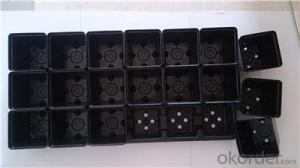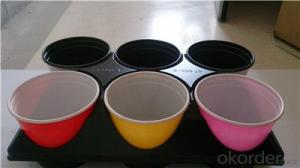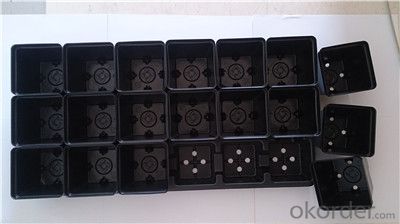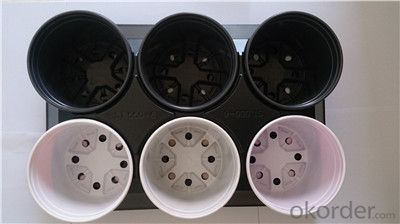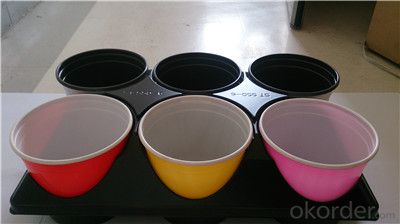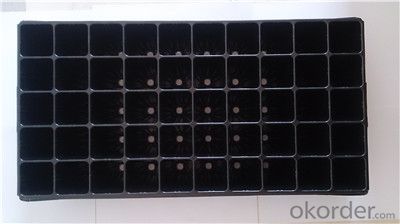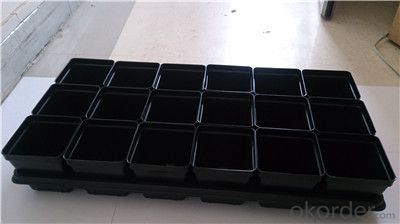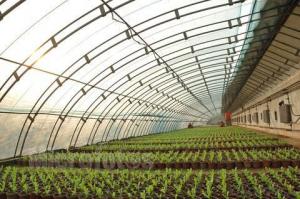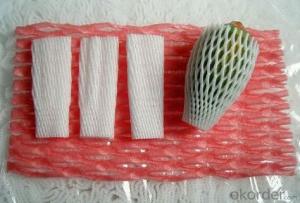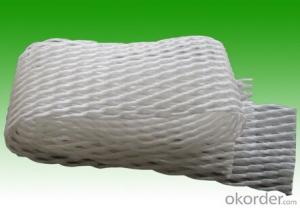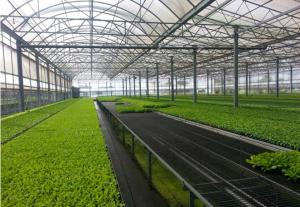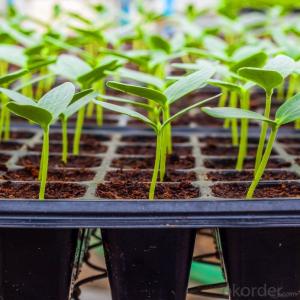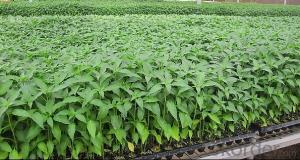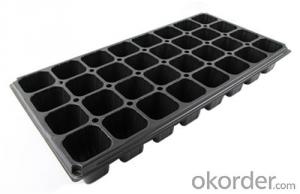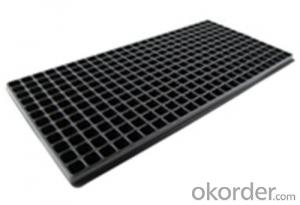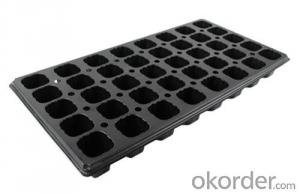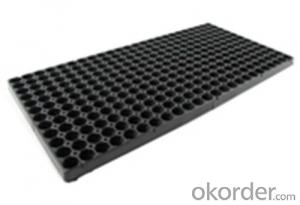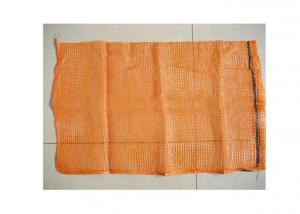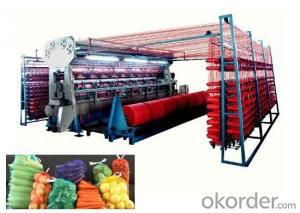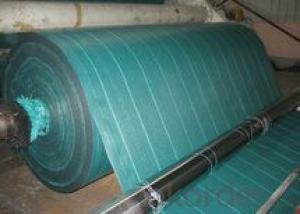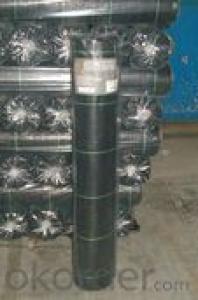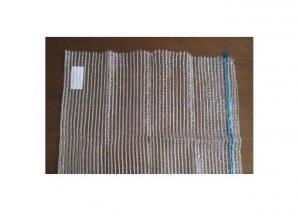Seed Tray Nursery Tray Plastic Tray with Cells Used for Greenhouse
- Loading Port:
- China main port
- Payment Terms:
- TT OR LC
- Min Order Qty:
- 3000 pc
- Supply Capability:
- 10000000 pc/month
OKorder Service Pledge
OKorder Financial Service
You Might Also Like
Product Description:
Advantages:
Top quality and competitive price.
Variety design and good appearance.
Easy to use, and remove.
Durable and reusable.
Eco-Friendly.
Application:
Ideal for Starting seeds and Transplanting Seedling.
Suitable for both manual and automatic planting.
Suitable for Propagating Vegetables, Flowers and other plant from seed in green-house or indoors.
Specification:
Material: HIPS/PVC
Thickness: 0.5mm-1.5mm, Standard:1mm
Weight: 80g(±5)g-230g(±5)g, Standard weight:155g(±5)g
Size: length:490mm-540mm, width:190mm-345mm,depth:25mm-150mm
Standard:54mmX28mm
Cell count: 18-512
Package: carton
Using time: 8-10 times
Thickness vs. Weight
Thickness of trays are from 0.5mm to 1.0mm.
1.0mm: 155g±5g; 100pcs/ctn.
0.9mm: 140g±5g; 120pcs/ctn.
0.7mm: 110g±5g; 150pcs/ctn.
0.6mm: 95g±5g; 180pcs/ctn.
0.5mm: 80g±5g; 200pcs/ctn.
Using time:
thickness of 0.5mm can be used 1 to 2 times.
thickness of 0.6mm can be used 3 to 4 times.
thickness of 0.7mm can be used 5 to 6 times.
thickness of 0.8mm can be used 7 to 8 times.
thickness of 0.9mm can be used 8 to 9 times.
thickness of 1.0mm can be used 8 to 10 times.
Weight and thickness as follows
| Thickness | Weight |
| 0.5mm | 80g±5g |
| 0.6mm | 95g±5g |
| 0.7mm | 105g±5g |
| 0.8mm | 125g±5g |
| 0.9mm | 140g±5g |
| 1.0mm | 155g±5g |
| 1.1mm | 170g±5g |
| 1.2mm | 185g±5g |
| 1.3mm | 200g±5g |
| 1.4mm | 215g±5g |
| 1.5mm | 230g±5g |
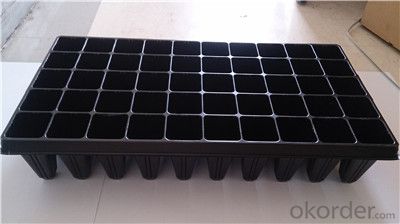
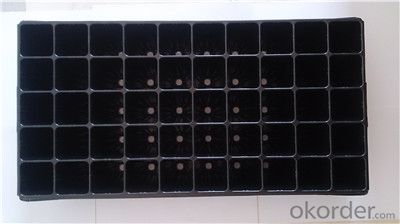
- Q: Do nursery trays come with a humidity dome?
- Yes, nursery trays often come with a humidity dome.
- Q: i don't know this but i think plastic is a very good heat insulator
- plastic takes in a rather broad spectrum. It is a medium to poor conductor of heat. plastic that has closed cell air bubbles like a coffee cup acts as an excellent insulator, however it is the air pockets that make it effective. Plastics can be used on cookware to give an insulated handle. Epoxy compounds can join materials that need thermal conduction, especially if the epoxy is doped with metal plastic is blind to radiation, so it allows ice to form quickly when the tray is put in the freezer as heat radiates out of the water. far superior in function to aluminum trays even though aluminum is a better conductor of heat.
- Q: Can nursery trays be used for starting plants from root cuttings?
- Yes, nursery trays can be used for starting plants from root cuttings. Nursery trays provide a convenient and efficient way to propagate plants from root cuttings, allowing for proper drainage and spacing of individual cuttings.
- Q: What are some ground cover options for slopes?
- Some ground cover options for slopes include creeping phlox, creeping thyme, vinca minor, sedum, and English ivy.
- Q: This question asks for an overview of the methods used to recycle plastic products from agricultural activities.
- <p>Recycling methods for agricultural plastic products include mechanical recycling, chemical recycling, and energy recovery. Mechanical recycling involves shredding and reprocessing the plastic into new products. Chemical recycling breaks down the plastic into its chemical components, which can then be used to create new plastics or other products. Energy recovery involves incinerating the plastic to generate energy, though this method is less environmentally friendly due to emissions. Additionally, biodegradable plastics are being developed for agricultural use, which can decompose naturally, reducing the need for recycling. Proper collection and sorting are crucial for effective recycling, and some regions have implemented take-back programs to encourage the return of used agricultural plastics for recycling.</p>
- Q: Can nursery trays be used for starting native herb seeds?
- Yes, nursery trays can be used for starting native herb seeds. Nursery trays provide a convenient and organized way to sow and grow seeds, allowing for better control over moisture and temperature. Using nursery trays for starting native herb seeds can help ensure successful germination and healthy seedlings.
- Q: What is the recommended spacing between plants in a nursery tray?
- The recommended spacing between plants in a nursery tray typically depends on the specific type of plants being grown. However, a general guideline is to provide enough space for each plant to have room to grow and develop without overcrowding or competing for resources. This usually ranges from 1 to 4 inches between plants, allowing for proper air circulation and preventing the spread of diseases. It is essential to consider the mature size of the plants and their growth habits to determine the appropriate spacing for optimal growth and health.
- Q: Are nursery trays made of plastic?
- Yes, nursery trays are typically made of plastic.
- Q: I am painting my cousins plastic trunk before she goes off to camp. I outlined everything in pencil and I was wondering what kind of paint I should use so it doesn't chip off the trunk? The trunk is pink and plastic, the surface is rough as well. Any ideas?
- plastic model paint? I hope you find what your needing.
- Q: What are the rules or suggestions for using plastic mulch in organic farming?
- <p>Yes, there are specific regulations and guidelines for using agricultural plastic mulch in organic farming. Organic farming standards vary by country, but generally, they aim to promote sustainable and natural farming practices. In many regions, the use of synthetic plastic mulches is not allowed in organic farming because they are not biodegradable and can cause environmental pollution. Instead, organic farmers are encouraged to use natural mulches like straw, grass, or leaves, which decompose and enrich the soil. However, some organic certification programs may allow the use of certain biodegradable or compostable mulches under specific conditions. It is essential to consult the organic certification standards applicable in your region for precise guidelines.</p>
Send your message to us
Seed Tray Nursery Tray Plastic Tray with Cells Used for Greenhouse
- Loading Port:
- China main port
- Payment Terms:
- TT OR LC
- Min Order Qty:
- 3000 pc
- Supply Capability:
- 10000000 pc/month
OKorder Service Pledge
OKorder Financial Service
Similar products
Hot products
Hot Searches
Related keywords
